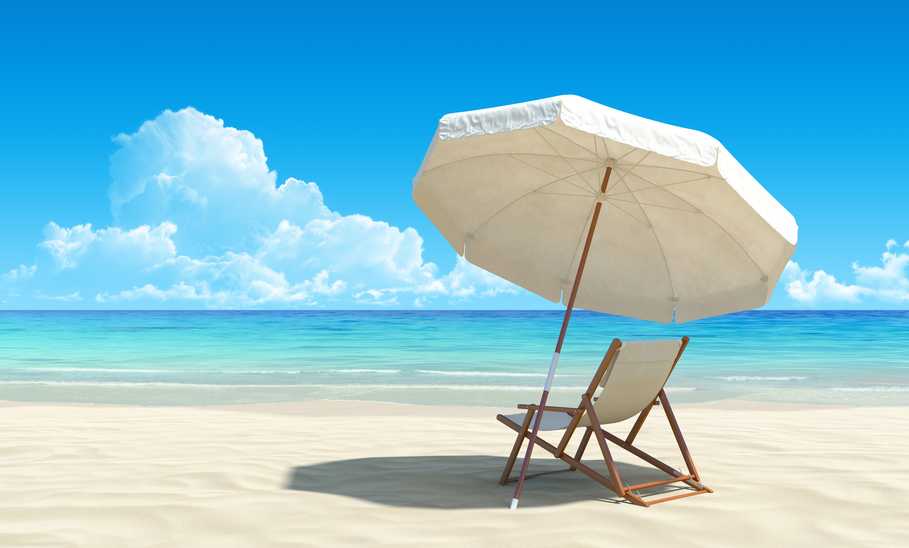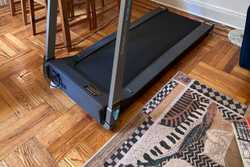- Height: 6.7 feet
- Weight: 9 pounds
- Canopy Size: 7.2 feet
- Material: Oxford fabric, steel, fiberglass, aluminum
- Wind Resistance: Not listed
- UPF: 50+
- Price: $60.27 at Walmart
11 Best Beach Umbrellas of 2024 to Protect you from the Sun

Our evaluations and opinions are not influenced by our advertising relationships, but we may earn a commission from our partners’ links. This content is created by TIME Stamped, under TIME’s direction and produced in accordance with TIME’s editorial guidelines and overseen by TIME’s editorial staff. Learn more about it.
The weather is warming up and that means it’s time to hit the beach. Whether you’re regularly jumping into the water or a fan of chilling on the sand, one thing everyone can agree on is the importance of suitable sun protection. An umbrella can be a game changer for long days on the beach, providing useful shade and a comfortable place to relax for you and your companions.
The real question is which is the right umbrella for you? Today’s brands have something for everyone, but it can be overwhelming to find your perfect match. We’ve scoured the web to find this elite selection of umbrellas, with something for every budget and preference. Follow our guidance below on how to choose the right kind of beach umbrella for your summertime activities, then take a look at our line-up of the best umbrellas on the market.
Taking all those necessities and preferences into consideration, we’ve compiled this list of top performers in the beach umbrella category. Whatever your needs, there’s a perfect fit amongst the 11 best umbrellas listed below.
![[object Object] [object Object]](https://i5.walmartimages.com/asr/2de1b5f3-87ab-4607-9c1e-c14828b53b49.fbb32cae50576678cbbed12ab8f02cc2.jpeg?odnHeight=640&odnWidth=640&odnBg=FFFFFF)
Budget picks are usually associated with lesser quality, but there’s no need to compromise with this option from Blissun. Available at some retailers for under $50, this beach umbrella includes a sand anchor for greater stability and a carry bag for improved portability. The canopy stretches over seven feet, making it a good choice for pairs, and the shaft has a push-button tilt feature so that users can easily adjust the angle of the shade for better sun protection. Despite being on the cheaper end, this umbrella utilizes fiberglass supports for greater durability and the canopy includes a vent to help with wind stability. While not the sturdiest or most stylish choice, the Blissun Portable Beach Umbrella is a solid all-rounder that’s great value for the price tag.
![[object Object] [object Object]](https://c.shld.net/rpx/i/s/pi/mp/10153480/prod_18675392824?src=https%3A%2F%2Fimages-na.ssl-images-amazon.com%2Fimages%2FI%2F41QMK0HAv0S.jpg&d=5ad4c36eae4f3887816b19c20a7c8c6451928580)
You get a lot of bang for your buck with the BeachBUB All-in-One Beach Umbrella System. As well as the umbrella, it features a base, carry bag and accessory kit, which includes a sand shovel and towel hook. When unassembled, the entire system only weighs nine pounds and the carry bag features a padded strap for easier portability.
Rather than relying solely on an anchor for stability, the BeachBUB system uses a tarp that lays flat on the sand and is then filled with sand to weigh it down. This eliminates any need for digging or screwing anchors; reviewers report that assembly can be completed in as little as five minutes once you’re familiar with the set-up. This also makes it easy to adjust the angle of the umbrella as needed. With a canopy reaching 7.5 feet, a wind resistance rating of 44 mph and UPF protection of 50+, this is premium-level shade. Although not cheap, you get what you pay for. In case there are any issues with durability, the manufacturer offers a three-year warranty.
![[object Object] [object Object]](https://shibumishade.com/cdn/shop/files/Shibumi22_2_1.png?v=1681218689)
Many beachgoers are replacing their traditional upright umbrellas with tents or beach canopies and it’s easy to see why with the Shibumi Shade. The open canopy style needs only three mph of wind to stay upright, while eliminating any risk of blowing away with the wind. Assembly is a breeze and easily accomplished by one person in a couple of minutes. The entire package consists solely of tent poles, fabric and a carry case that also functions as a sand anchor, coming in at a lightweight four pounds. The very large canopy allows for up to 150 sq. ft of shade, making this a popular choice for larger groups of four to six people, whether using beach chairs or beach towels. There’s also an added sustainability component, as Shibumi uses 40% recycled plastic bottles for its shades. While the open canopy can be louder than other umbrella options, particularly in higher wind speeds, this is a highly durable choice that warrants the higher retail price.
![[object Object] [object Object]](https://outdoormaster.com/cdn/shop/files/NewVersion-BlueWhiteStripedwithCupHolder_900x.jpg?v=1693968917)
Sometimes the best wind option is something like a tent, which offers greater stability, or a canopy, which offers less wind resistance. However, the OutdoorMaster Beach Umbrella is the perfect choice for those looking for a more traditional beach umbrella that will stand up to strong gusts. Although the company doesn’t list a specific wind resistance number, the umbrella features fiberglass ribs and a two-way rotation tilt mechanism that supports angle adjustments up to 180 degrees, so it can comfortably flex with shifting winds. Instead of the traditional sand anchor, the OutdoorMaster utilizes a sandbag that can accommodate 44 pounds of sand, for easy assembly and portability. There’s even an extra perk: the umbrella includes handy cup holders to keep your beverages and personal items out of the sand.
When it comes to maximum shade, the Sun Ninja tent is a great mix of affordability, stability and coverage. The expansive canopy comfortably provides cover for four to six people on beach towels or beach chairs and there’s a larger size available for bigger groups.
Unlike the Shibumi Shade, which requires some wind to stay upright, the Sun Ninja tent relies on sandbags to keep it anchored and is therefore equally as effective on still days as it is on breezy ones. The spandex material ensures it’s light to travel with at just over seven pounds and the package comes with pegs, in case you want to use it on grass. The only negative is that the Sun Ninja tent does take up quite a lot of real estate and may therefore not be as practical—or popular—of an option on busy beach days. On the flipside, this ensures bountiful space to relax away from the sun.
![[object Object] [object Object]](https://dks.scene7.com/is/image/dkscdn/22IFOUSPRTBRLLPRMREC_Blue_is?$UTPMain$?$DSG_Google_PLA$)
It can be difficult to choose between a classic umbrella or a sun-tent, but there’s no need to choose with the Sport-Brella Premier eight foot Umbrella Shelter. Featuring a single central tentpole, this umbrella stands at an angle to accommodate drop-down panels that create an open tent shape. This ensures extra privacy and protection from the elements, without the complicated assembly of a full tent. A sturdy beach anchor ensures that the hybrid umbrella tent won’t fly away in strong winds, while the extra coverage also doubles as protection against unexpected rain or bad weather.
Additionally, zippered window openings and interior pockets allow for convenient airflow and storage—and there’s always the option to use this as a traditional umbrella too, although it will have to stand at an angle and may not accommodate beach chairs underneath. This is a particularly good choice if you’re often braving the elements at your local beach.
![[object Object] [object Object]](https://m.media-amazon.com/images/I/41bQflA0dDL._SL500_.jpg)
Some of the top options on our list offer the latest in modern technology, but the Frankford Umbrella has been a classic choice since it first appeared soon after World War II. With a stylish central pole made out of ash wood, instead of the more common metal, and a canopy made of heavy duty OLEFIN fabric, this is an umbrella designed to last. In fact, it’s so durable that the manufacturer offers a five year warranty, which helps explain the more expensive price. But it’s not just a long-time favorite for its performance:
The Frankford Umbrella’s tall frame and classic domed shade make it popular among luxury hotels such as the Ritz-Carlton and the Fontainebleau. Although heavy to carry, this heft helps increase the umbrella’s stability. Just remember to buy a separate sand anchor for maximum security, as this product doesn’t have one included.
![[object Object] [object Object]](https://assets.wfcdn.com/im/11717114/resize-h800-w800%5Ecompr-r85/1379/137953263/96%27%27+Beach+Umbrella.jpg)
This lightweight option from Caribbean Joe hides a lot of performance in its simple frame. Made from advanced UV-protected material, this classic beach umbrella is able to provide substantial sun protection under its eight foot canopy (UPF 50 protection). The 16-ribbed frame is designed for wind resistance, and the canopy opens to a full arc (and can tilt to adjust to the sun’s position). It’s only about six pounds, making it great for carrying over longer distances. The vent details within the canopy allow air to move for added wind resistance as well.
![[object Object] [object Object]](https://i5.walmartimages.com/seo/Tommy-Bahama-7-Red-Blue-Beach-Umbrella-With-Built-In-Table-And-Integrated-Sand-Anchor_931b0d24-4cb9-4ec3-81f6-c562b27dbe08_1.febd0a1cdbb023f9eba340ff100b578e.jpeg?odnHeight=2000&odnWidth=2000&odnBg=FFFFFF)
The Tommy Bahama beach umbrella may not be the hippest option around but it’s one of the most reliable and popular umbrellas that we found. With a built-in sand anchor, this umbrella is a breeze to set up and there’s no compromising on stability, whether you’re assembling your tent on the beach or on turf. A large seven foot canopy, 20 inches of adjustable height and a tilt feature provide substantial, flexible shade so that you can easily keep up with the sun as it moves across the sky. The Tommy Bahama umbrella features fiberglass ribs and an air vent for maximum flexibility against stronger winds, while an interior aluminum coating boosts the level of sun protection. For under $100, this is a great choice you can rely on year after year.
![[object Object] [object Object]](https://dks.scene7.com/is/image/dkscdn/22QXCUNS1BCHSNSHDREC_Periwinkle_Blue_is?$UTPMain$?$DSG_Google_PLA$)
At just four pounds including aluminum poles, the Neso Beach Sunshade is the lightest and easiest beach shade to transport. It’s also one of the easiest to assemble, with sandbags replacing any sand anchors and only two poles to insert. Nevertheless, this beach tent provides considerable protection from the sun thanks to its large footprint and UPF 50+ materials. Like the Sun Ninja, the Neso does require a lot of space but can therefore accommodate several people under its shade. It holds up well to different wind strengths, thanks to its four separate sandbags distributing the weight. All in all, this minimalist choice is ideal for larger groups who are happy to travel a little further afield to find a more quiet stretch of beach.
![[object Object] [object Object]](https://m.media-amazon.com/images/I/41N2N45Tn2L._SL500_.jpg)
The Wondershade Ultimate Portable Sun Shade is designed for use throughout the summer, whether it’s set up on the patio, in the park or on the beach. To achieve this, the brand includes a tripod standing base for fuss-free assembly on solid surfaces, as well as a built-in sand anchor for the beach.
When using the tripod base, set-up can take just seconds; the anchor isn’t much more work. This umbrella from Wondershade also features a telescopic central pole for easy height adjustment, so in no time at all you can be relaxing in perfect shade. While not the lightest or sturdiest pick on our list, we know that ease of use is a top priority for many beachgoers—whether you’ve got young kids to entertain, a group of friends to relax with or just a good book to dive into. If that’s you, this might be your best choice.
As mentioned earlier, the beach umbrella market is a crowded one so we wanted to make sure only the most consistent performers appeared on our list. This meant umbrellas that were easy to use and transport, able to withstand at least medium-speed winds, and likely to last much longer than a single summer. We opened up our criteria to include the newer trend towards beach canopies and tents, but kept our UPF (Ultraviolet Protection Factor) requirements high; no product on this list has a UPF of less than 50. To finalize our selection, we conducted substantial research and took into account the perspectives of experts, customers and manufacturers, to make sure that these umbrellas were performing across the board.
Although everyone’s budget is different, affordability and value are likely top of mind when picking out an umbrella. Durability is also important; there’s nothing worse than investing in a new piece of equipment only for it to break after a few uses. This is especially true for beach umbrellas, which can collapse or fly off in a gust of wind if they’re not well-made.
Adequate UV protection is a must for every type of beachgoer, so we’ve only included umbrellas that offer sufficient shade from the sun. Finally, ease of assembly is a common priority for anyone who wants to spend more time enjoying their camp than setting it up.
Then there are individual preferences and requirements. Perhaps you’ll be carrying your umbrella on public transportation, or your preferred beach is a long walk away from available parking. In these cases, you’ll want to prioritize something portable and compact. For those who live in windier conditions or like to camp out for long days on the sand, strong sand anchors and wind resistance may be key. And, of course, there’s also aesthetics—whether your taste is minimal, luxurious or sporty, finding the right look may be high up on your list.
Perhaps the first criteria you’ll want to nail down is how big an umbrella you need. This means figuring out how many people will likely be using the item at any given time, but also what size of carry bag you’re comfortable holding. To maximize square footage while cutting down on weight, a sun tent or beach canopy is a strong choice; these can accommodate four to six people on beach towels or beach chairs while only weighing four to six pounds.
If you only need coverage for one to two people laying down, then a six-to-eight foot umbrella canopy should be more than sufficient. This is also a great choice for anyone who frequents busier beaches, where your neighbors might get angry about one of the more expansive beach tents on our list.
Umbrella set-up varies depending on the style. If you are using a sand anchor, you’ll need to screw the anchor into the sand and then insert the umbrella pole into the base, before you can open up the canopy. Some products will come with sand shovels to make this process easier. If your umbrella or tent uses sandbags instead, you will need to lay these bags out in their final positions and fill them with sand to weigh them down. Once completed, you can insert the necessary tent poles to create the height and open space.
Beach umbrellas are designed by nature to withstand the basic elements. Fabrics are water-resistant and UV-resistant, which means that maintenance is minimal. However, if your umbrella has got particularly dirty or covered in sand, simply hosing off the material should clear any debris without damaging the material. Let the fabric dry out before closing the umbrella, to reduce the risk of damp or mildew.
As seen on this list, many manufacturers and customers are gravitating towards alternatives to beach umbrellas. Beach canopies are less structured, making them more flexible in greater winds, while also offering a greater footprint of shade. This can be very appealing to larger groups or families, but runs the risk of creating trouble on busier patches of sand. Other beachgoers are choosing sun tents over umbrellas, due to their greater stability – tents will usually have several anchors into the ground, as opposed to just one. However, this extra fabric can be heavier to carry and more complicated to assemble, so it’s not the right choice for everyone.
The information presented here is created by TIME Stamped and overseen by TIME editorial staff. To learn more, see our About Us page.



